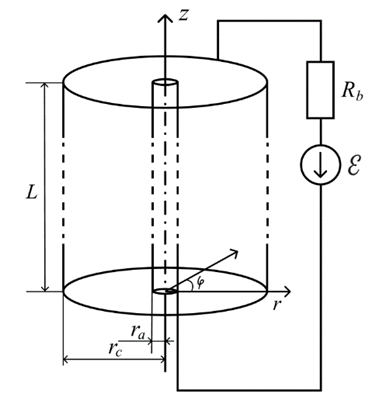Моделювання тліючого розряду в коаксіальній системі електродів
Основний зміст сторінки статті
Анотація
Виконано моделювання тліючого розряду в циліндричній коаксіальній системі з діелектричними торцями електродів в гідродинамічному дрейфово-дифузному наближенні. Параметри моделі: діаметр зовнішнього катода 10 та 13 мм, діаметр анода 2 мм, напруга 2800 В, температура газу 300 К. pd ~ 1 Па∙м, що відповідає лівій частині області мінімуму кривої Пашена для запалювання розряду. Були враховані реакції іонізації атомів електронним ударом, генерації та гасіння метастабільних атомів, пружнього зіткнення електронів з атомами та пружнє зіткнення іонів, резонансне перезарядження іонів, іонізація Пенінга, а також вторинна іонно-електронна емісія катода. Були розраховані в рамках самоузгодженої задачі розподіл потенціалу і концентрації заряджених частинок в міжелектродному проміжку, густини іонних і електронних струмів, представлені вольт-амперні характеристики для двух мод розряду - плазмового та безплазмового. Визначено вплив pd на параметри та моду розряду. Отримані результати можуть бути використані в плазмових технологіях модифікації внутрішніх поверхонь металевих, порожнистих, протяжних деталей з малим поперечним розміром, тобто в умовах близьких до ускладненого виникненням розряду.
Блок інформації про статтю

Ця робота ліцензується відповідно до Creative Commons Attribution 4.0 International License.
Автори, які публікуються у цьому журналі, погоджуються з наступними умовами:- Автори залишають за собою право на авторство своєї роботи та передають журналу право першої публікації цієї роботи на умовах ліцензії Creative Commons Attribution License, котра дозволяє іншим особам вільно розповсюджувати опубліковану роботу з обов'язковим посиланням на авторів оригінальної роботи та першу публікацію роботи у цьому журналі.
- Автори мають право укладати самостійні додаткові угоди щодо неексклюзивного розповсюдження роботи у тому вигляді, в якому вона була опублікована цим журналом (наприклад, розміщувати роботу в електронному сховищі установи або публікувати у складі монографії), за умови збереження посилання на першу публікацію роботи у цьому журналі.
- Політика журналу дозволяє і заохочує розміщення авторами в мережі Інтернет (наприклад, у сховищах установ або на особистих веб-сайтах) рукопису роботи, як до подання цього рукопису до редакції, так і під час його редакційного опрацювання, оскільки це сприяє виникненню продуктивної наукової дискусії та позитивно позначається на оперативності та динаміці цитування опублікованої роботи (див. The Effect of Open Access).
Посилання
Y. P. Raizer "Gas Discharge Physics, J. E. Allen ed., Heidelberg: Springer Berlin, 1991. ISBN: 978-3-642-64760-4
B. N. Klyarfeld, L. G. Guseva, and F. S. Pokrovskaya-Soboleva, “Glow discharge at low pressures and current density up to 0.1 A/cm2 [Tleyushchiy razryad pri nizkih davleniyah i plotnostyah toka do 0.1 A/cm2]”, Zhurnal Tehn. Fiziki, vol. 36, no. 4, pp. 704–713, Jan. 1966.
A. Fridman and L. A. Kennedy, 3rd ed. Third edition. | Boca Raton : CRC Press, 2021.: CRC Press, 2021. DOI: https://doi.org/10.1201/9781315120812
J. Reece Roth, "Industrial Plasma Engineering: Volume 1: Principles" (1st ed.), CRC Press, 1995. DOI: https://doi.org/10.1201/9780367802615
T. Aizawa and K. Wasa, “Low Temperature Plasma Nitriding of Inner Surfaces in Stainless Steel Mini-/Micro-Pipes and Nozzles”, Micromachines, vol. 8, no. 5, p. 157, May 2017. DOI: https://doi.org/10.3390/mi8050157
H. Aghajani and S. Behrangi, "Plasma Nitriding of Steels," Cham: Springer International Publishing, 2017. DOI: https://doi.org/10.1007/978-3-319-43068-3
P. Phadke, J. M. Sturm, R. W. van de Kruijs, and F. Bijkerk, “Sputtering and nitridation of transition metal surfaces under low energy, steady state nitrogen ion bombardment”, Applied Surface Science, vol. 505, p. 144529, Mar. 2020. DOI: https://doi.org/10.1016/j.apsusc.2019.144529
A. Kuzmichev, V. Perevertaylo, L. Tsybulsky, and O. Volpian, “Characteristics of flows of energetic atoms reflected from metal targets during ion bombardment”, Journal of Physics: Conference Series, vol. 729, p. 012005, Jul. 2016. DOI: https://doi.org/10.1088/1742-6596/729/1/012005
V. A. Lisovskiy and S. D. Yakovin, “Experimental study of a low-pressure glow discharge in air in large-diameter discharge tubes: I. conditions for the normal regime of a glow discharge”, Plasma Physics Reports, vol. 26, no. 12, pp. 1066–1075, Dec. 2000. DOI: https://doi.org/10.1134/1.1331142
A. Bouchikhi, “Two-Dimensional Numerical Simulation of the DC Glow Discharge in the Normal Mode and with Einstein’s Relation of Electron Diffusivity”, Plasma Science and Technology, vol. 14, no. 11, pp. 965–973, Nov. 2012. DOI: https://doi.org/10.1088/1009-0630/14/11/04
P. G. C. Almeida, M. S. Benilov, and M. J. Faria, “Study of stability of dc glow discharges with the use of Comsol Multiphysics software”, Journal of Physics D: Applied Physics, vol. 44, no. 41, p. 415203, Sep. 2011. DOI: https://doi.org/10.1088/0022-3727/44/41/415203
P. G. C. Almeida and M. S. Benilov, “Multiple solutions in the theory of near-cathode layers and self-organization on DC glow cathodes”, in 2008 IEEE 35th International Conference on Plasma Science, Karlsruhe, Germany, 2008, pp. 1–1. DOI: https://doi.org/10.1109/PLASMA.2008.4591201
R. Kumar, R. Narayanan, R. D. Tarey, and A. Ganguli, “Characterization of DC glow discharge plasma in co-axial electrode geometry system by nonlinear dynamical analysis tools”, Physics of Plasmas, vol. 30, no. 1, Jan. 2023. DOI: https://doi.org/10.1063/5.0111124
A. Bouchikhi and A. Hamid, “2D DC Subnormal Glow Discharge in Argon”, Plasma Science and Technology, vol. 12, no. 1, pp. 59–66, Feb. 2010. DOI: https://doi.org/10.1088/1009-0630/12/1/13
Plasma Module User's Guide, pp. 76-83. COMSOL Multiphysics® v. 6.2. COMSOL AB, Stockholm, Sweden. 2023 URL: https://doc.comsol.com/6.2/doc/com.comsol.help.plasma/PlasmaModuleUsersGuide.pdf
G. J. M. Hagelaar and L. C. Pitchford, “Solving the Boltzmann equation to obtain electron transport coefficients and rate coefficients for fluid models”, Plasma Sources Science and Technology, vol. 14, no. 4, pp. 722–733, Oct. 2005. DOI: https://doi.org/10.1088/0963-0252/14/4/011
A. I. Kuzmichev, “Gas discharge systems with secondary emitters for electronic equipment”, Kyiv, 2018, p. 425.
A. Bogaerts and R. Gijbels, “Numerical modelling of gas discharge plasmas for various applications”, Vacuum, vol. 69, no. 1-3, pp. 37–52, Dec. 2002. DOI: https://doi.org/10.1016/S0042-207X(02)00306-8
Surzhikov S.T. Computational Physics of Electric Discharges in Gas Flows (De Gruyter Studies in Mathematical Physics, 7). Walter de Gruyter GmbH, Berlin/Boston. 2012. 439 p. ISBN: 9783110270334





